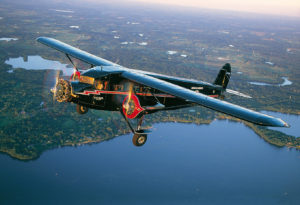Project Description

MPH
SEATS
Stinson Tri-Motor Model B
Role: Transport
National Origin: United States
Manufacturer: Stinson Aircraft Company
First Flight: 1931
Primary User: American Airlines
Number Built: 40
Comparatively low-priced and quite economical for the amount of work it could perform, the Stinson trimotor “Model T” (SM-6000-B) found ready favor with new and expanding airline systems across the country. Stately, confidence-inspiring, hardy, and very dependable, the SM-6000-B served the various airlines faithfully for several years; when retired from regular service most were relegated to further service on lesser lines, or to “barnstorm” the countryside in the mid-thirties. These barnstorming tours, very much like those of the gipsy-fliers in the decade previous, were a haphazard living at best but the cheap joy-rides brought many people their first airplane ride, winning over many new converts to air-travel. Excellent performance, inherent safety, and a compatible nature helped to promote the popularity and the longevity of the SM-6000-B.
The Stinson trimotor model SM-6000-B (Model T) was a large high-winged cabin monoplane of the transport type with various seating arrangements for 6 to 10 passengers. The model SM-6000-B1 was the all-passenger version seating 10 passengers and a pilot; arranged with coach-style interiors, this version allowed just short of 25 Ibs. of baggage per person. The model SM-6000-B2 as the mail-passenger version was the more popular, with arrangements for 8 or 9 passengers and bins for up to 350 lbs. of mail and baggage. Extensively upgraded from the earlier SM-6000 “Airliner”‘, the SM-6000-B now had provisions for extra equipment, more pilot aids, more comfort for the passengers, including washroom and lavatory, and other progressive modifications that added to its usefulness in airline service. With all passenger seating removed, the SM-6000-B was also eligible as a cargo-carrier. For the business man, special “Club” interiors were available to seat from 6 to 8 passengers in varying degrees of deluxe com-fort, for just traveling in style or for conducting business enroute. As powered with three 9 cylinder Lycoming R-680 engines of 215 h.p. each, the SM-6000-B delivered a performance that certainly belied its well-apparent bulk. With a low-drag speed-ring cowling shrouding each of its engines, and large streamlined fairings over the big wheels, this craft could maintain a top speed of 146 m.p.h. With a fair amount of power reserve, the trimotor SM-6000-B could maintain an altitude of 6000 ft. with any two of its engines, even when fully loaded. A take-off run of about 700 ft. and a landing run of about 400 ft. was not particularly essential for airline work, but it was particularly appreciated later on by pilots barnstorming out of small turf-covered fields. Typical of all Stinson monoplanes, the big SM-6000-B cooperated with the pilot to perform an admirable job, no matter what the chore.
The type certificate number for the trimotor SM-6000-B was issued 4-23-31 and at least 40 examples of this model were manufactured by the Stinson Aircraft Corp, at Wayne, Michigan.
General characteristics
- Crew: 2 (pilot, co-pilot)
- Capacity: 10 passengers
- Length: 42 ft 0 in (12.8 m)
- Wingspan: 60 ft 0 in (18.29 m)
- Height: 12 ft 0 in (3.66 m)
- Wing area: 490 sq ft (45.6 m²)
- Empty weight: 5,670 lb (2,620 kg)
- Powerplant: 3 × Lycoming R-680, 215 hp (160 kW) each
Performance
- Maximum speed: 146 mph (234 km)
- Cruise speed: 125 mph (200 km/h)
- Range: 390 mi (628 km)
- Service ceiling: 14,200 ft (4,330 m)
- Rate of climb: 1,000 ft/min (5.1 m/s)